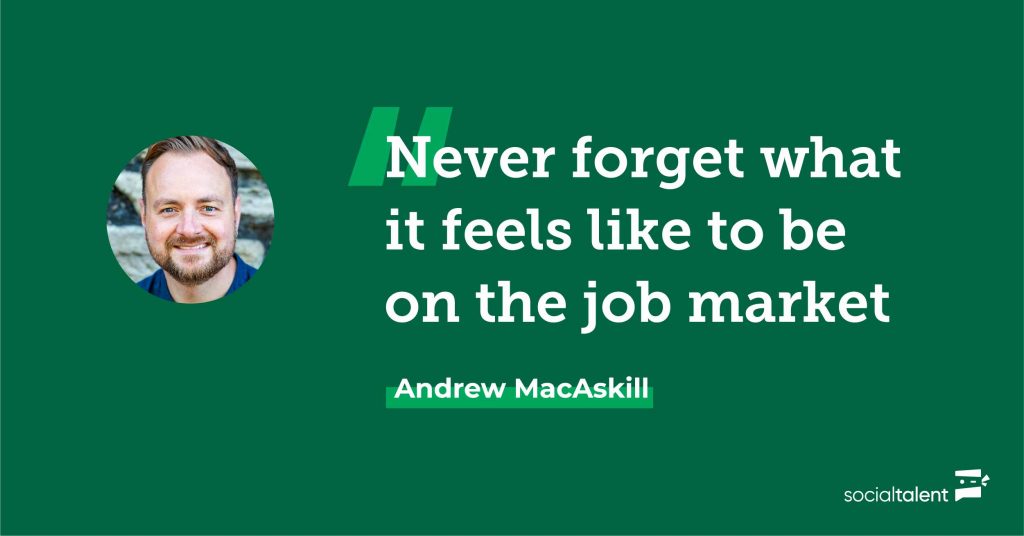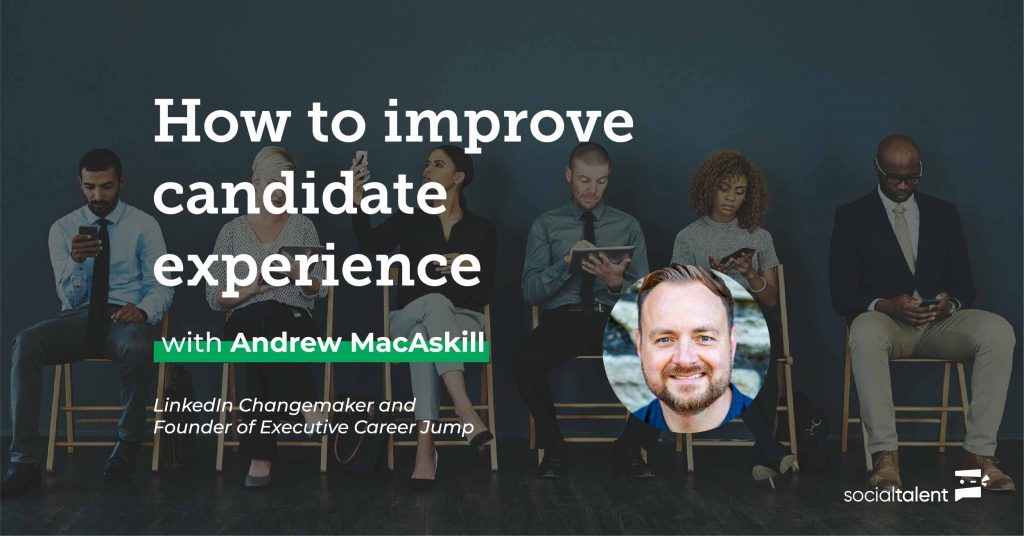How to improve candidate experience, with Andrew MacAskill
Understanding what your audience wants is crucial, no matter what industry you are in. But when it comes to hiring, often a lot of focus is given to the organization’s mindset and values – the things they want from employees. However, if you were to look behind the veil, at what candidates themselves are really searching for in jobs and roles, do you think that the two would be aligned?
We recently had the pleasure of sitting down with Andrew MacAskill to talk about this. Andrew is an author, LinkedIn Changemaker and Founder of Executive Career Jump – a company that specializes in job search and career progression coaching. From his insights and advice, we’ve compiled a list of top tips to ensure your candidate experience is optimized and effective.
1. Why is candidate experience so important now?
According to Andrew, the world of work has changed more in the last 10 years than the 50 that preceded it. Trends are accelerating and people’s view on work, and what they want out of it, are altering at a drastic scale. From increased flexibility and remote work options to more fractional careers, organizations must get ahead of these new employee needs if they want to secure top talent. And this is where candidate experience becomes so vital.
“Hiring is the first touch point,” Andrew tells us. It is the opportunity to sell your company, provide clarity and inspire success. Every interaction in this process matters. And with the job seeker market being so tight right now, it’s never been more important to ensure your candidate experience is specifically optimized to the candidate, and not the organization. Top candidates have plenty of choice right now, and positive candidate experience can be a huge differentiator.
2. What are candidates looking for?
Andrew summed this up for us perfectly – it’s all about “the head, heart and wallet.” In the past, candidates were first incentivized by the package. Then, it became the environment they worked in. Finally, the company mission or purpose trumped all else. Current job seekers want all of this. They are not willing to sacrifice elements of their careers, especially when they know they have options elsewhere. It’s like a checklist, and if organizations want to create a successful candidate experience, they must first address these three hygiene factors of competitive salary, flexibility within the working model and an authentic mission.
After this, Andrew told us that there needs to be a back-to-basics approach to the process. Candidates are very clear about what they want from their application and hiring experience:
- Transparency
- Pace
- Clear assessments
- Authenticity
And these are all elements that organizations can, and should, continually work on and adjust. Don’t make candidates jump through hoops – cut through the noise, streamline the process and be upfront about expectations and information.

3. The importance of creating an authentic candidate experience
Candidates are considerably more discerning these days. According to Andrew, “the level of due diligence that these digital natives are doing prior to going to interview is unprecedented.” They are seeking out organizations who walk the talk, unpicking the grandiose marketing messages on careers pages and job adverts to find the real stories. Candidates are looking further afield at comments made on a leader’s personal LinkedIn account, appearances at conferences and events on YouTube, or Glassdoor reviews. They’re looking for uncurated information before making any sort of move.
So why not provide some upfront? “There is this idea,” Andrew tells us, “that we have to get all the positives out there.” But there are huge downsides to this, especially around overpromising and under delivering, dipping engagement levels post-hire and signalling a lack of trust. Selling a dream that doesn’t exist is detrimental – candidates want to know that they’ll have an opportunity to make real impact, and this can be a huge driver. Be honest about where difference can be made and use it as a selling-point, rather than a badly kept secret.
Looking to improve your candidate experience? SocialTalent recruitment sourcing courses’ can help! We have missions and courses designed to optimize and enhance the process. Get in-touch with us today.
4. Candidates join leaders, not a jobs
Another change Andrew disclosed, which has been percolating for some time, is around how candidates are picking a leader to work for, rather than a particular role or organization. It’s an intriguing development, but one that makes sense. Your fulfilment in work is so often attributed to a manager or team head, so making this a priority when searching for a career is an intriguing way to ensure your own contentment and development. Leaders are a huge reason why employees join, stay, or leave companies. But there is a way to leverage this trend…
Embracing and encouraging leadership marketing and personal branding within your organization is an incredible way to passively build a career funnel. Andrew recommends that leaders nurture their brand and presence online; aim to organically get your voice and thought-leadership on to LinkedIn and other forums to build awareness and clout. But it must be done thoughtfully – remember, candidates are looking for authenticity. Andrew gave us an incredible example of the benefits of this while speaking on The Shortlist, saying that after clients had taken part in personal branding training and adopted some of the practices, they saw an incredible 300% increase in traffic to their company career page!
SocialTalent has a comprehensive program dedicated to leadership development. Check out a preview of the content here.
5. Providing candidate feedback
A final component of an effective candidate experience strategy revolves around feedback. According to Andrew, a lot of organizations opt for vague language like “pipped to the post by another applicant” when offering feedback, or even just completely ghosting unsuccessful candidates. This is a useless practice. Instead, we should look to the A,B,C approach to feedback that is:
- Actionable
- Balanced
- Compassionate
Andrew has a 3+3 policy when it comes to feedback – three things the candidate can work on, and three things they did really well. “People can tolerate a no,” he says, “but only when they’ve been told why.” Providing feedback like this can build such good sentiment over time too, even turning unsuccessful candidates into advocates for your company.
Feedback can be a powerful tool for good, even when rejecting a candidate.
The final tip Andrew gave us was this: “never forget what it feels like to be on the job market.” If we infuse candidate experience with this kind of empathy, strategy, and authenticity, you’re sure to create a process which not only entices top talent, but also bolsters your employer brand and improves awareness. It’s win-win-win!
Catch Andrew’s full appearance on The Shortlist:
About Andrew:

